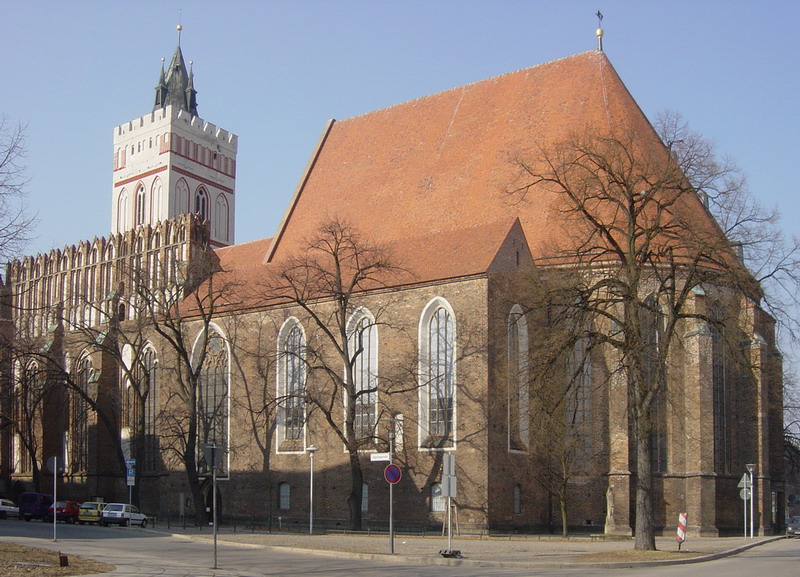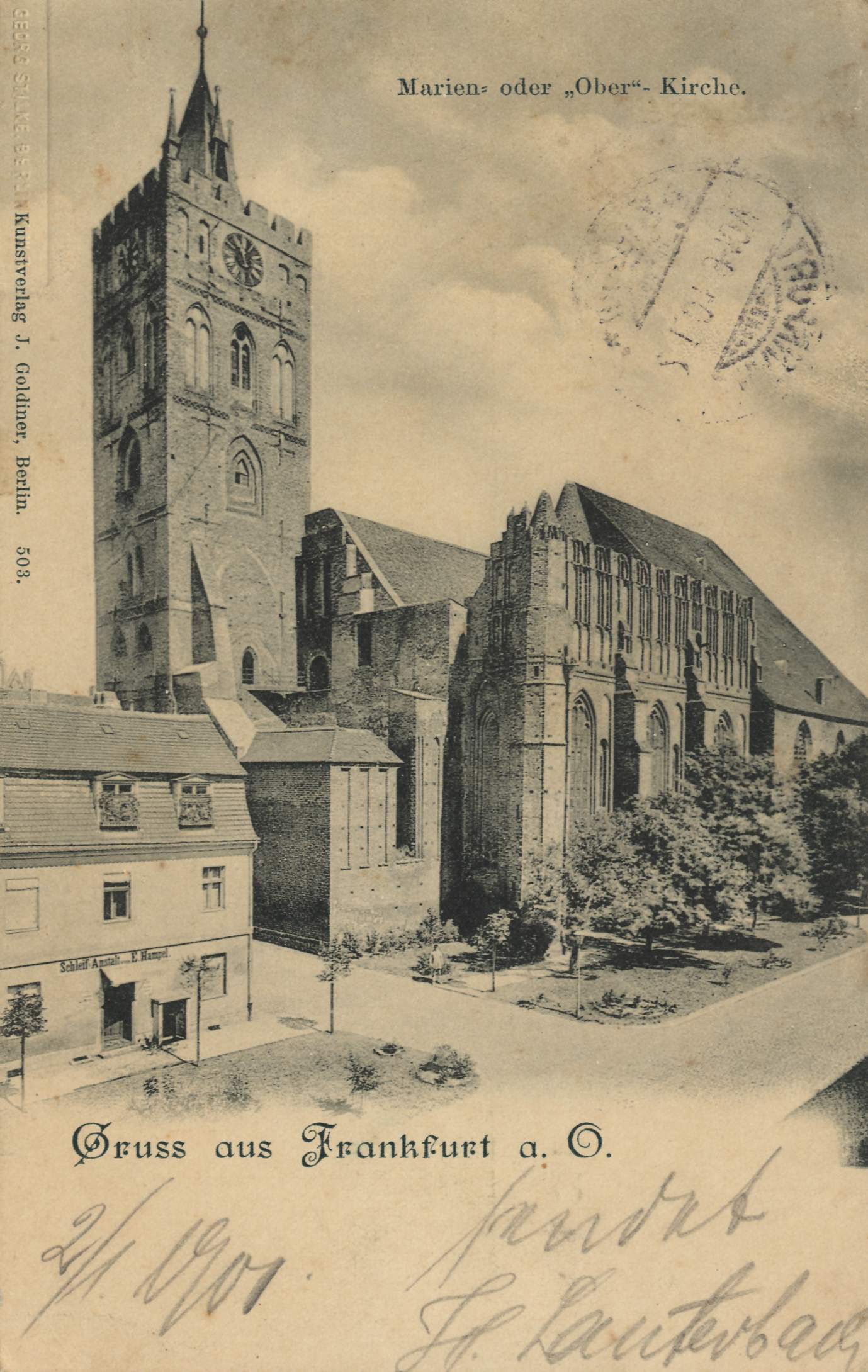Marienkirche, Frankfurt (Oder) on:
[Wikipedia]
[Google]
[Amazon]





 The Marienkirche is a Protestant church in
The Marienkirche is a Protestant church in
Official site
{{Authority control Churches in Frankfurt (Oder) FrankfurtOder Marienkirche FrankfurtOder Marienkirche Protestant churches in Brandenburg




 The Marienkirche is a Protestant church in
The Marienkirche is a Protestant church in Frankfurt (Oder)
Frankfurt (Oder), also known as Frankfurt an der Oder (), is a city in the German state of Brandenburg. It has around 57,000 inhabitants, is one of the easternmost cities in Germany, the fourth-largest city in Brandenburg, and the largest German ...
in Germany. It was formerly the city's main parish church and was built over more than 250 years, during the Middle Ages.
History
To 1522
It was first built in 1253, just after the foundation of the city, and was one of the earliest examples of a gallery in the architecture of theMargraviate of Brandenburg
The Margraviate of Brandenburg (german: link=no, Markgrafschaft Brandenburg) was a major principality of the Holy Roman Empire from 1157 to 1806 that played a pivotal role in the history of Germany and Central Europe.
Brandenburg developed out o ...
. An ambulatory
The ambulatory ( la, ambulatorium, ‘walking place’) is the covered passage around a cloister or the processional way around the east end of a cathedral or large church and behind the high altar. The first ambulatory was in France in the 11th ...
hall was built to replace the original choir and a polygonal entrance hall with a sandstone entrance arch built onto the north transept
A transept (with two semitransepts) is a transverse part of any building, which lies across the main body of the building. In cruciform churches, a transept is an area set crosswise to the nave in a cruciform ("cross-shaped") building withi ...
, both between 1360 and 1370. The nave was expanded as a five-bayed construction in the 15th century with painted ceilings in the side bays and a 14-storey new tower façade built around 1450. An eight-pointed cupola was added to the north tower and a crenellated edge to the south tower. On the establishment of the Viadrina University
European University Viadrina Frankfurt (Oder) (german: Europa-Universität Viadrina Frankfurt (Oder)) is a university located at Frankfurt (Oder) in Brandenburg, Germany. It is also known as the University of Frankfurt (Oder). The city is on the ...
a new galleried sacristy
A sacristy, also known as a vestry or preparation room, is a room in Christian churches for the keeping of vestments (such as the alb and chasuble) and other church furnishings, sacred vessels, and parish records.
The sacristy is usually located ...
was built between 1521 and 1522 – this was the last major expansion of the building, which is now 77 metres long and 25 metres wide, making it one of the largest Brick Gothic
Brick Gothic (german: Backsteingotik, pl, Gotyk ceglany, nl, Baksteengotiek) is a specific style of Gothic architecture common in Northeast and Central Europe especially in the regions in and around the Baltic Sea, which do not have resourc ...
buildings in Germany.
Stained glass
The three large surviving Gothic stained glass windows date to between 1360 and 1370 – they are made up of a total of 117 pictures, each 83 x 43 cm in size, financed by city's citizens of the city and showing the creation, the lives of Adam and Eve, Noah building his ark, Christ's life and theBook of Revelation
The Book of Revelation is the final book of the New Testament (and consequently the final book of the Christian Bible). Its title is derived from the first word of the Koine Greek text: , meaning "unveiling" or "revelation". The Book of R ...
. They were removed to another location in Frankfurt in September 1941 to protect them from bombing – there they were photographed in black and white before being moved to the New Palace in Potsdam
Potsdam () is the capital and, with around 183,000 inhabitants, largest city of the German state of Brandenburg. It is part of the Berlin/Brandenburg Metropolitan Region. Potsdam sits on the River Havel, a tributary of the Elbe, downstream of B ...
in April 1945.
In June 1946 they were seized from Potsdam by the Soviet Military Administration in Germany
The Soviet Military Administration in Germany (russian: Советская военная администрация в Германии, СВАГ; ''Sovyetskaya Voyennaya Administratsiya v Germanii'', SVAG; german: Sowjetische Militäradministrat ...
and taken to the Red Army Spoils of War Camp 1 at Zentralvieh- und Schlachthof in Berlin. They were then moved to the Hermitage Museum
The State Hermitage Museum ( rus, Государственный Эрмитаж, r=Gosudarstvennyj Ermitaž, p=ɡəsʊˈdarstvʲɪn(ː)ɨj ɪrmʲɪˈtaʂ, links=no) is a museum of art and culture in Saint Petersburg, Russia. It is the list of ...
's stores in August 1946 and were thus considered as "lost since the end of the war". The windows' new location was first revealed in April 1991 by the Literaturnaya Gazeta
''Literaturnaya Gazeta'' (russian: «Литературная Газета», ''Literary Gazette'') is a weekly cultural and political newspaper published in Russia and the Soviet Union. It was published for two periods in the 19th century, and ...
. In 1994 Frankfurt's parish council petitioned the Russian prime minister Viktor Chernomyrdin
Viktor Stepanovich Chernomyrdin (russian: Ви́ктор Степа́нович Черномы́рдин, ; 9 April 19383 November 2010) was a Soviet and Russian politician and businessman. He was the Minister of Gas Industry of the Soviet Unio ...
for their return, leading to a law passed in the State Duma
The State Duma (russian: Госуда́рственная ду́ма, r=Gosudárstvennaja dúma), commonly abbreviated in Russian as Gosduma ( rus, Госду́ма), is the lower house of the Federal Assembly of Russia, while the upper house ...
with the approval of the Federation Council
The Federation Council (russian: Сове́т Федера́ции – ''Soviet Federatsii'', common abbreviation: Совфед – ''Sovfed''), or Senate (officially, starting from July 1, 2020) ( ru , Сенат , translit = Senat), is th ...
in April 2002 to return the windows. They were gradually restored in a room above the church's sacristy from summer 2002 onwards, using the black and white wartime photographs.
The first of the three windows was ceremonially reinstalled on 28 May 2005. In June 2005 a message appeared in the Russian newspaper Kommersant
''Kommersant'' (russian: Коммерсантъ, , ''The Businessman'' or Commerce Man, often shortened to Ъ) is a nationally distributed daily newspaper published in Russia mostly devoted to politics and business. The TNS Media and NRS Russia ...
that six missing panels from the windows were in the Pushkin Museum
The Pushkin State Museum of Fine Arts (russian: Музей изобразительных искусств имени А. С. Пушкина, abbreviated as ) is the largest museum of European art in Moscow, located in Volkhonka street, just oppo ...
and after several further years of negotiations the Duma and Federation Council also decided to return these panels, handing them to the German embassy in Moscow. The German culture minister Bernd Neumann
Bernd Otto Neumann (born 6 January 1942) is a former German politician and since 2014 president of the German Federal Film Board (FFA).
Biography
Neumann was born in Elbing, East Prussia, now Elbląg, Poland. Following the flight and expu ...
then handed them over to the parish and the city on 17 November 2008 and the last pieces of the windows were reinstalled in the church in February 2009.
1826–present
On 15 May 1826 the south tower of the church collapsed –Karl Friedrich Schinkel
Karl Friedrich Schinkel (13 March 1781 – 9 October 1841) was a Prussian architect, city planner and painter who also designed furniture and stage sets. Schinkel was one of the most prominent architects of Germany and designed both neoclassica ...
's rebuild completely walled off a Gothic display wall from the 13th century, which was only rediscovered during repairs in the 1990s. Schinkel entrusted his scheme to his pupil Emil Flaminius
Emil Karl Alexander Flaminius (1807, Küstrin - 7 October 1893, Berlin) was a Prussian architect and master builder.
History
Flaminius grew up in Küstrin during the Napoleonic Wars and the period of reconstruction after the departure of the Nap ...
, although it did not include rebuilding the lost south tower. The church was ruined during the destruction of downtown Frankfurt in April 1945 and partially collapsed. Its sacristy and Martyrchor (Martyrs' choir) were rebuilt and the nave altar brought back into use by the parish using its own funds in 1958, but the limited heating meant services could only occur in the summer. The city council and the church signed a 99-year lease on 27 September 1974 so that it could continue using the church, with the city taking over restoration and rebuilding of the ruins for general civic purposes. This began in 1979, restoring the sacristy, and continued in 1990. The main roofs over the chancel and nave were rebuilt in 1998. Reconstruction concluded with the restoration of the original coloured façade of the north tower after colour pigments were discovered on it. Since 1980 its church furniture have been in the Sankt-Gertraud-Kirche – these include the 1489 Marienaltar, its late 14th century bronze font and bronze candlesticks and many tomb monuments and inscriptions.
The church was equipped with a 38,000 euro fire protection system in 2002. In May 2006, the road in front of the west door was repaved – historic granite stones from the civil engineering department's store and some donors' stones (each costing 75 Euros, of which 50 Euros went to the restoration fund and 25 Euros to producing the stone) were used for this purpose.
Bells
Library
References
External links
Official site
{{Authority control Churches in Frankfurt (Oder) FrankfurtOder Marienkirche FrankfurtOder Marienkirche Protestant churches in Brandenburg